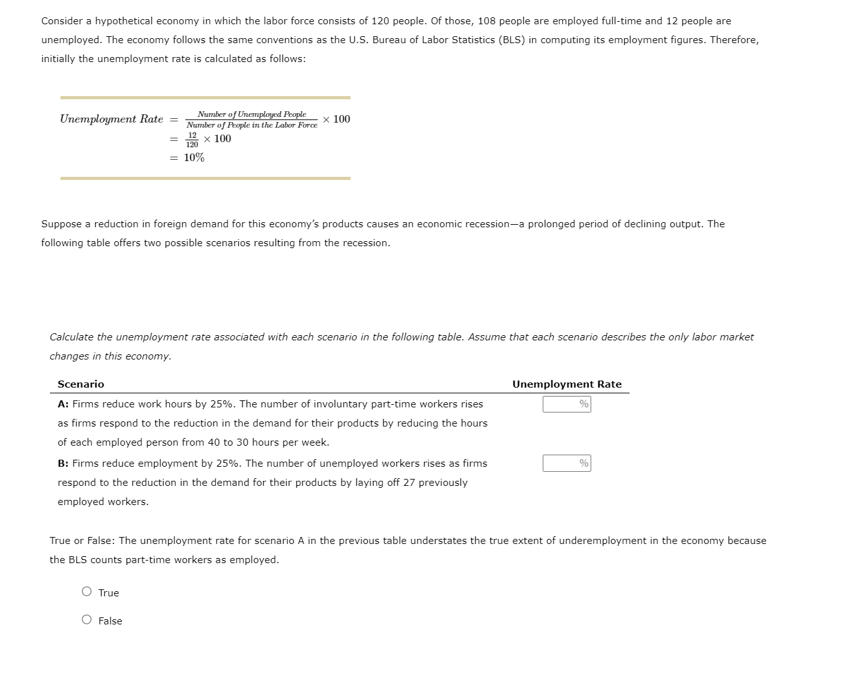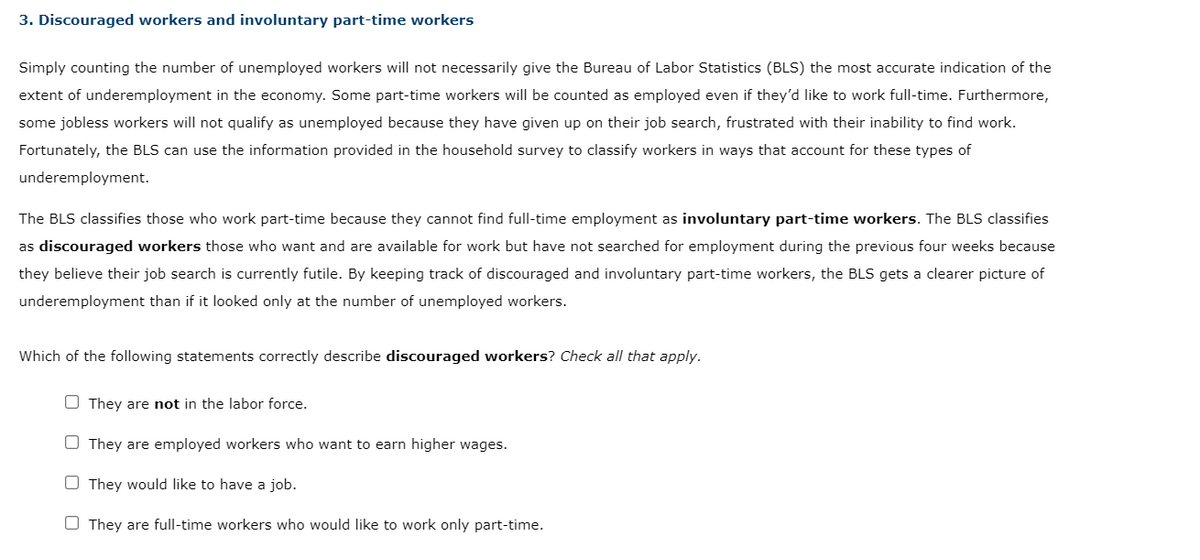Consider a hypothetical economy in which the labor force consists of 120 people. Of those, 108 people are employed full-time and 12 people are unemployed. The economy follows the same conventions as the U.S. Bureau of Labor Statistics (BLS) in computing its employment figures. Therefore, initially the unemployment rate is calculated as follows: Unemployment Rate = == Number of Unemployed People Number of People in the Labor Force × 100 12 120 = 10% x 100 Suppose a reduction in foreign demand for this economy's products causes an economic recession-a prolonged period of declining output. The following table offers two possible scenarios resulting from the recession. Calculate the unemployment rate associated with each scenario in the following table. Assume that each scenario describes the only labor market changes in this economy. Scenario A: Firms reduce work hours by 25%. The number of involuntary part-time workers rises as firms respond to the reduction in the demand for their products by reducing the hours of each employed person from 40 to 30 hours per week. B: Firms reduce employment by 25%. The number of unemployed workers rises as firms respond to the reduction in the demand for their products by laying off 27 previously employed workers. Unemployment Rate % True or False: The unemployment rate for scenario A in the previous table understates the true extent of underemployment in the economy because the BLS counts part-time workers as employed. True O False 3. Discouraged workers and involuntary part-time workers Simply counting the number of unemployed workers will not necessarily give the Bureau of Labor Statistics (BLS) the most accurate indication of the extent of underemployment in the economy. Some part-time workers will be counted as employed even if they'd like to work full-time. Furthermore, some jobless workers will not qualify as unemployed because they have given up on their job search, frustrated with their inability to find work. Fortunately, the BLS can use the information provided in the household survey to classify workers in ways that account for these types of underemployment. The BLS classifies those who work part-time because they cannot find full-time employment as involuntary part-time workers. The BLS classifies as discouraged workers those who want and are available for work but have not searched for employment during the previous four weeks because they believe their job search is currently futile. By keeping track of discouraged and involuntary part-time workers, the BLS gets a clearer picture of underemployment than if it looked only at the number of unemployed workers. Which of the following statements correctly describe discouraged workers? Check all that apply. They are not in the labor force. They are employed workers who want to earn higher wages. They would like to have a job. They are full-time workers who would like to work only part-time.
Consider a hypothetical economy in which the labor force consists of 120 people. Of those, 108 people are employed full-time and 12 people are unemployed. The economy follows the same conventions as the U.S. Bureau of Labor Statistics (BLS) in computing its employment figures. Therefore, initially the unemployment rate is calculated as follows: Unemployment Rate = == Number of Unemployed People Number of People in the Labor Force × 100 12 120 = 10% x 100 Suppose a reduction in foreign demand for this economy's products causes an economic recession-a prolonged period of declining output. The following table offers two possible scenarios resulting from the recession. Calculate the unemployment rate associated with each scenario in the following table. Assume that each scenario describes the only labor market changes in this economy. Scenario A: Firms reduce work hours by 25%. The number of involuntary part-time workers rises as firms respond to the reduction in the demand for their products by reducing the hours of each employed person from 40 to 30 hours per week. B: Firms reduce employment by 25%. The number of unemployed workers rises as firms respond to the reduction in the demand for their products by laying off 27 previously employed workers. Unemployment Rate % True or False: The unemployment rate for scenario A in the previous table understates the true extent of underemployment in the economy because the BLS counts part-time workers as employed. True O False 3. Discouraged workers and involuntary part-time workers Simply counting the number of unemployed workers will not necessarily give the Bureau of Labor Statistics (BLS) the most accurate indication of the extent of underemployment in the economy. Some part-time workers will be counted as employed even if they'd like to work full-time. Furthermore, some jobless workers will not qualify as unemployed because they have given up on their job search, frustrated with their inability to find work. Fortunately, the BLS can use the information provided in the household survey to classify workers in ways that account for these types of underemployment. The BLS classifies those who work part-time because they cannot find full-time employment as involuntary part-time workers. The BLS classifies as discouraged workers those who want and are available for work but have not searched for employment during the previous four weeks because they believe their job search is currently futile. By keeping track of discouraged and involuntary part-time workers, the BLS gets a clearer picture of underemployment than if it looked only at the number of unemployed workers. Which of the following statements correctly describe discouraged workers? Check all that apply. They are not in the labor force. They are employed workers who want to earn higher wages. They would like to have a job. They are full-time workers who would like to work only part-time.
Principles of Economics 2e
2nd Edition
ISBN:9781947172364
Author:Steven A. Greenlaw; David Shapiro
Publisher:Steven A. Greenlaw; David Shapiro
Chapter21: Unemployment
Section: Chapter Questions
Problem 16RQ: Assess whether the following would be counted as unemployed in the Current Employment Statistics...
Related questions
Question

Transcribed Image Text:Consider a hypothetical economy in which the labor force consists of 120 people. Of those, 108 people are employed full-time and 12 people are
unemployed. The economy follows the same conventions as the U.S. Bureau of Labor Statistics (BLS) in computing its employment figures. Therefore,
initially the unemployment rate is calculated as follows:
Unemployment Rate =
==
Number of Unemployed People
Number of People in the Labor Force × 100
12
120
= 10%
x 100
Suppose a reduction in foreign demand for this economy's products causes an economic recession-a prolonged period of declining output. The
following table offers two possible scenarios resulting from the recession.
Calculate the unemployment rate associated with each scenario in the following table. Assume that each scenario describes the only labor market
changes in this economy.
Scenario
A: Firms reduce work hours by 25%. The number of involuntary part-time workers rises
as firms respond to the reduction in the demand for their products by reducing the hours
of each employed person from 40 to 30 hours per week.
B: Firms reduce employment by 25%. The number of unemployed workers rises as firms
respond to the reduction in the demand for their products by laying off 27 previously
employed workers.
Unemployment Rate
%
True or False: The unemployment rate for scenario A in the previous table understates the true extent of underemployment in the economy because
the BLS counts part-time workers as employed.
True
O False

Transcribed Image Text:3. Discouraged workers and involuntary part-time workers
Simply counting the number of unemployed workers will not necessarily give the Bureau of Labor Statistics (BLS) the most accurate indication of the
extent of underemployment in the economy. Some part-time workers will be counted as employed even if they'd like to work full-time. Furthermore,
some jobless workers will not qualify as unemployed because they have given up on their job search, frustrated with their inability to find work.
Fortunately, the BLS can use the information provided in the household survey to classify workers in ways that account for these types of
underemployment.
The BLS classifies those who work part-time because they cannot find full-time employment as involuntary part-time workers. The BLS classifies
as discouraged workers those who want and are available for work but have not searched for employment during the previous four weeks because
they believe their job search is currently futile. By keeping track of discouraged and involuntary part-time workers, the BLS gets a clearer picture of
underemployment than if it looked only at the number of unemployed workers.
Which of the following statements correctly describe discouraged workers? Check all that apply.
They are not in the labor force.
They are employed workers who want to earn higher wages.
They would like to have a job.
They are full-time workers who would like to work only part-time.
Expert Solution
This question has been solved!
Explore an expertly crafted, step-by-step solution for a thorough understanding of key concepts.
This is a popular solution!
Trending now
This is a popular solution!
Step by step
Solved in 2 steps with 1 images

Recommended textbooks for you

Principles of Economics 2e
Economics
ISBN:
9781947172364
Author:
Steven A. Greenlaw; David Shapiro
Publisher:
OpenStax

Essentials of Economics (MindTap Course List)
Economics
ISBN:
9781337091992
Author:
N. Gregory Mankiw
Publisher:
Cengage Learning

Brief Principles of Macroeconomics (MindTap Cours…
Economics
ISBN:
9781337091985
Author:
N. Gregory Mankiw
Publisher:
Cengage Learning

Principles of Economics 2e
Economics
ISBN:
9781947172364
Author:
Steven A. Greenlaw; David Shapiro
Publisher:
OpenStax

Essentials of Economics (MindTap Course List)
Economics
ISBN:
9781337091992
Author:
N. Gregory Mankiw
Publisher:
Cengage Learning

Brief Principles of Macroeconomics (MindTap Cours…
Economics
ISBN:
9781337091985
Author:
N. Gregory Mankiw
Publisher:
Cengage Learning

Principles of Economics (MindTap Course List)
Economics
ISBN:
9781305585126
Author:
N. Gregory Mankiw
Publisher:
Cengage Learning

Principles of Economics, 7th Edition (MindTap Cou…
Economics
ISBN:
9781285165875
Author:
N. Gregory Mankiw
Publisher:
Cengage Learning

Principles of Macroeconomics (MindTap Course List)
Economics
ISBN:
9781285165912
Author:
N. Gregory Mankiw
Publisher:
Cengage Learning